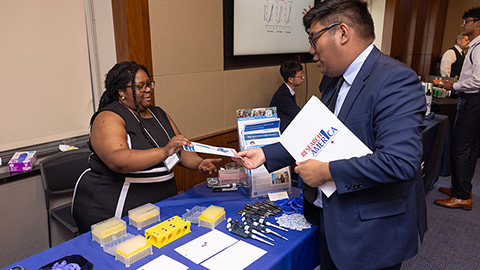Groups step up to prevent student homelessness during academic breaks
Without her full-ride scholarship to Cal State San Bernardino, third-year sociology student Syerra Gardner may have been unable to pursue higher education altogether.
“I knew that I had to graduate high school, but I just didn’t know what I wanted to do after,” said Gardner, who learned about the scholarship from a high school counselor while living in a homeless shelter. “She was just explaining all these great things that I’m able to apply for to be able to make a life for myself, and I took the

But Gardner could have faced homelessness again if it wasn’t for programs and scholarships that make it possible for her to stay in the dorms over winter and summer breaks. She lives in campus dorms, a cost that her scholarship covers during the school year, where she typically has access to the school’s meal plans. During academic breaks, she largely relies on canned food, her campus food pantry, or CalFresh, the state’s food benefits program.
Even if colleges have empty dorm rooms for the winter and summer breaks, students who need places to live have to come up with the money to cover the dorm room and board costs.
Without a safe family home to rely on, Gardner is left to fend for herself during those academic breaks. For students like her who can’t afford the housing and living costs, that’s where organizations play a crucial role, like GiveBack, which awarded Gardner the full-ride scholarship, SchoolHouse Connection, a nonprofit working to end homelessness through policy advocacy and funding for students, and Guardian Scholars, a chapter-based organization on college campuses that helps support former foster and homeless youth.
Such support for students like Gardner is life-changing. But, getting the help can be all-consuming.
When the onus is placed on off-campus organizations or the students themselves to seek resources that will cover the cost between academic breaks, the result is an exhausting, stressful focus on housing and food security rather than focusing on doing well in school.
Students who leave school or don’t do well in class are often dealing with other distractions like their living arrangements, said Bryan Spencer, assistant director of the Education Opportunity Program at San Diego State University, which operates their campus Guardian Scholars. “If we can eliminate or reduce those barriers as much as possible, it really gives every student the best opportunity to focus on their academics, their career transitions, and getting involved on campus.”
As such, their Guardian Scholars program has created a unique housing solution by partnering with the university and the San Diego Housing Commission, which is operated by the city’s Department of Urban and Housing Development. When students apply to the California State University system and self-identify as current or former foster youth, under legal guardianship, or unaccompanied minors, the Guardian Scholars staff emails them separately with a program application. Students can then receive a housing scholarship, where the amount depends on several factors, such as whether they live on or off campus, the size of their housing unit and whether they have roommates.
Students who live on campus may sign a housing contract for year-round housing that includes winter and summer breaks. If they live off campus, the housing scholarship will set up automatic monthly payments to the landlord for the duration of the housing contract.
As long as the student remains enrolled in classes, they do not have to worry about their housing.
“The housing award is a game changer,” said Spencer, who has worked on the San Diego campus since 2006. Before the housing award was implemented, Spencer and his colleagues would often help support students in crisis housing situations. Typically, before the winter and summer breaks, students would share that they would soon have to couch-surf or have nowhere to live, and staff would step in to find housing or funding for them.
Now, six years later, he can’t recall any student facing a similar housing crisis.
The team hopes the housing support model can be replicated across California. For campuses that might not yet be able to, advocates suggest using available resources in creative ways.
“It is difficult for schools to intercede and provide year-round comprehensive support on students’ behalf, but I think that there are resources and opportunities that exist on campus that could benefit these students,” said Jordyn Roark, director of youth leadership and scholarships at SchoolHouse Connection.
For example, Roark continued, campuses often hire students as orientation leaders to help sign up incoming freshmen for classes and to welcome them onto campus. These orientation sessions are often on a staggered schedule to keep the orientation groups smaller, and they may include staying on the campus for a few days.
“Maybe doing some targeted outreach to students that need housing and seeing if they’re interested in participating as an orientation leader would provide them with employment during the summer, as well as housing,” she said.
To help students, SchoolHouse Connection offers $2,000 scholarships and other emergency funding.
“We give it to them in the way that they feel would most benefit them. We try to be as unrestricted as possible,” said Roark. “The flexibility with funding ensures that students can apply it toward any living expense, such as housing, a laptop, a cellphone or meals.”
Securing stable housing through summer and winter breaks can sometimes make or break a student’s ability to graduate from college, according to advocates.
While Gardner has family in Southern California, moving in with them even for a short period of time would take her back to the unstable and sometimes unsafe homes she experienced before college.
She began attending college after a few rough and unstable years in high school, moving from one grandmother’s house to a friend’s home to her second grandmother’s home. She was living by herself in a homeless shelter when she was awarded the full-ride scholarship during her senior year of high school.
“It was just so amazing,” said Gardner, who only applied to that one scholarship. “Everything was going great from there.”
During Gardner’s first summer break, she was awarded a SchoolHouse Connection scholarship. She had to sign her first loan to cover some housing costs for her second summer break.
Now in her third summer at CSU San Bernardino, she’s received an additional grant from GiveBack. She’s covering the remaining balance through her on-campus job working as a teaching assistant to children who have disabilities.
While resources for students like Gardner often exist on California campuses, students are largely left to fend for themselves when trying to access them.
“This housing crisis for students comes down to a campus-by-campus approach, where every campus provides something different, and oftentimes what they provide is buried under web pages, long resources, and deep in offices that students aren’t even aware exist,” said Roark. “What I find is that our students don’t even know where to begin to identify those resources.”
Roark and other advocates are fueling a movement by way of a federal policy called the Higher Education Access and Success for Homeless and Foster Youth Act of 2022, to hire a liaison at every college campus so that students facing homelessness know exactly whom they can go to when they are in need. According to them, such liaison roles would function similarly to the liaisons that every K–12 school across the country is federally mandated to hire to help connect young homeless students with resources available to them.
Those K–12 liaisons are hired under the McKinney–Vento Homeless Assistance Act, which requires that every public school district, county office of education and charter school hire a local liaison to ensure that homeless youth in grades pre-K through 12 are identified and have education services coordinated for them to increase their chances of succeeding academically.
Upon graduating next year, Gardner wants to use her life experiences to help children facing similar challenges.
“I want to be able to experience the world, meet all types of different kids, help them in the situations that they’re in — whether they’ve been adopted, in foster care, homeless, or have incarcerated parents,” she said. “I just want them to be able to know that you’re not alone in the situation.”
This article originally appeared in EdSource.
Enjoy reading ASBMB Today?
Become a member to receive the print edition four times a year and the digital edition monthly.
Learn moreFeatured jobs
from the ASBMB career center
Get the latest from ASBMB Today
Enter your email address, and we’ll send you a weekly email with recent articles, interviews and more.
Latest in Policy
Policy highlights or most popular articles

Embrace your neurodivergence and flourish in college
This guide offers practical advice on setting yourself up for success — learn how to leverage campus resources, work with professors and embrace your strengths.

ASBMB honors Lawrence Tabak with public service award
He will deliver prerecorded remarks at the 2025 ASBMB Annual Meeting in Chicago.

Summer internships in an unpredictable funding environment
With the National Institutes of Health and other institutions canceling summer programs, many students are left scrambling for alternatives. If your program has been canceled or delayed, consider applying for other opportunities or taking a course.

Black excellence in biotech: Shaping the future of an industry
This Black History Month, we highlight the impact of DEI initiatives, trailblazing scientists and industry leaders working to create a more inclusive and scientific community. Discover how you can be part of the movement.

ASBMB releases statement on sustaining U.S. scientific leadership
The society encourages the executive and legislative branches of the U.S. government to continue their support of the nation’s leadership in science.

ASBMB and advocacy: What we accomplished in 2024
PAAC members met with policymakers to advocate for basic scientific research, connected some fellow members with funding opportunities and trained others to advocate for science.

